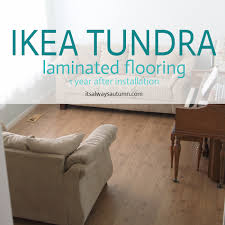Ikea Laminate Flooring Problems

I state this now: I will never use laminate flooring again. I don’t care how inexpensive and near-indestructable it is — the stuff simply is not well-designed and is far too cumbersome for one person to install alone. The need for a second person is ridiculous and if nothing else points out the usability of the product.I’m ranting because I’m on night #2 trying to get this stuff into the basement while Alex and the wee one are out of town. I’m pulling long nights, spending virtually every moment downstairs wrestling with a Tarkett laminate we purchased a couple of weekends ago.I’m trying to do this mostly as a surprise for Alex — finish off as much of the basement as I can, so that when she comes home the upstairs is fully liveable, and the main room of the downstairs is finally useable. It won’t be complete, but it’ll at least be a start. And we can start to live in this house, rather than merely exist.The instructions printed on the insert with each box make it sound simple.

This stuff is the “clickable” type, which means there are special hooked grooves that interlock. The idea is that once the stuff is down, it doesn’t separate and you don’t get the gaps common with ordinary tongue-and-groove types.It’s a complete and utter myth. This stuff is actually worse than tongue-and-groove. Especially if you’re one person. When you lay down the first row, it’s easy — lay end-to-end, and they magically interlock.
Maine Coon Cat Rescue GeorgiaThe problems begin with the second row.
Aek Original T ShirtAccording to instructions, you lay down the row end-to-end, and then slide the entire row into the previous one, completing the effect.
Buy Bengal Cat Dallas TxIn principle, it makes sense.But it never works. Once you get one section of the row in place, another part pops back out.

The interlock is tenuous. And you can’t tap it into place with a hammer. Although the floor is durable, the grooves are flimsy as hell, and are prone to breakage. I’ve got gaps everywhere. They’re not just unsightly, they’re highly annoying. I can already foresee cuts forming.And no, I don’t have any friends I can call on. I’m doing this installation until well into the morning, and I can’t ask friends to stay up that late to help me. It’s simply just not acceptable.Next time, I’ll use engineered hardwood. Or the real thing. But I’m sure as hell never using laminate again. I wish the floor had been regular concrete…WASHINGTON — A decade after emergency trailers meant to shelter Hurricane Katrina victims instead caused burning eyes, sore throats and other more serious ailments, the Environmental Protection Agency is on the verge of regulating the culprit: formaldehyde, a chemical that can be found in commonplace things like clothes and furniture.But an unusual assortment of players, including furniture makers, the Chinese government, Republicans from states with a large base of furniture manufacturing and even some Democrats who championed early regulatory efforts, have questioned the E.P.A. proposal.

The sustained opposition has held sway, as the agency is now preparing to ease key testing requirements before it releases the landmark federal health standard.The E.P.A.’s five-year effort to adopt this rule offers another example of how industry opposition can delay and hamper attempts by the federal government to issue regulations, even to control substances known to be harmful to human health.Formaldehyde is a known carcinogen that can also cause respiratory ailments like asthma, but the potential of long-term exposure to cause cancers like myeloid leukemia is less well understood.The E.P.A.’s decision would be the first time that the federal government has regulated formaldehyde inside most American homes. “The stakes are high for public health,” said Tom Neltner, senior adviser for regulatory affairs at the National Center for Healthy Housing, who has closely monitored the debate over the rules. “What we can’t have here is an outcome that fails to confront the health threat we all know exists.”

The proposal would not ban formaldehyde — commonly used as an ingredient in wood glue in furniture and flooring — but it would impose rules that prevent dangerous levels of the chemical’s vapors from those products, and would set testing standards to ensure that products sold in the United States comply with those limits. The debate has sharpened in the face of growing concern about the safety of formaldehyde-treated flooring imported from Asia, especially China.What is certain is that a lot of money is at stake: American companies sell billions of dollars’ worth of wood products each year that contain formaldehyde, and some argue that the proposed regulation would impose unfair costs and restrictions.Determined to block the agency’s rule as proposed, these industry players have turned to the White House, members of Congress and top E.P.A. officials, pressing them to roll back the testing requirements in particular, calling them redundant and too expensive. Document: The Formaldehyde Fight

“There are potentially over a million manufacturing jobs that will be impacted if the proposed rule is finalized without changes,” wrote Bill Perdue, the chief lobbyist at the American Home Furnishings Alliance, a leading critic of the testing requirements in the proposed regulation, in one letter to the E.P.A.Industry opposition helped create an odd alignment of forces working to thwart the rule. The White House moved to strike out key aspects of the proposal. Subsequent appeals for more changes were voiced by players as varied as Senator Barbara Boxer, Democrat of California, and Senator Roger Wicker, Republican of Mississippi, as well as furniture industry lobbyists.Hurricane Katrina in 2005 helped ignite the public debate over formaldehyde, after the deadly storm destroyed or damaged hundreds of thousands of homes along the Gulf of Mexico, forcing families into temporary trailers provided by the Federal Emergency Management Agency.The displaced storm victims quickly began reporting respiratory problems, burning eyes and other issues, and tests then confirmed high levels of formaldehyde fumes leaking into the air inside the trailers

, which in many cases had been hastily constructed. Public health advocates petitioned the E.P.A. to issue limits on formaldehyde in building materials and furniture used in homes, given that limits already existed for exposure in workplaces. But three years after the storm, only California had issued such limits.Industry groups like the American Chemistry Council have repeatedly challenged the science linking formaldehyde to cancer, a position championed by David Vitter, the Republican senator from Louisiana, who is a major recipient of chemical industry campaign contributions, and whom environmental groups have mockingly nicknamed “Senator Formaldehyde.”By 2010, public health advocates and some industry groups secured bipartisan support in Congress for legislation that ordered the E.P.A. to issue federal rules that largely mirrored California’s restrictions. At the time, concerns were rising over the growing number of lower-priced furniture imports from Asia that might include contaminated products, while also hurting sales of American-made products.